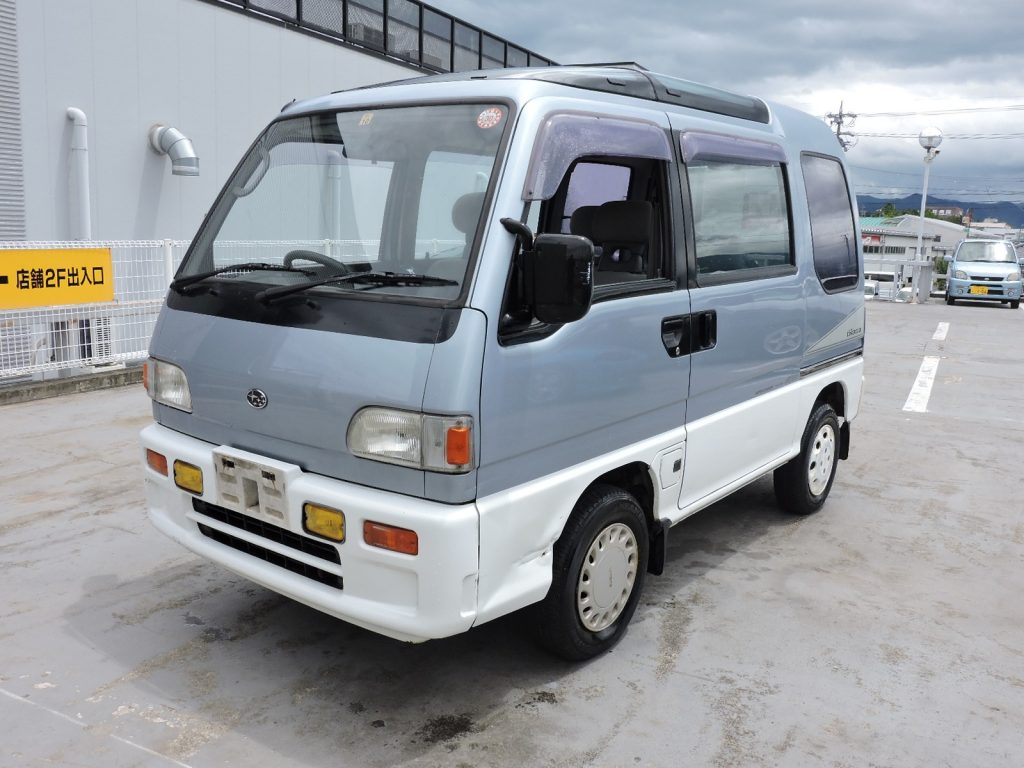I spotted this vehicle online on June 25, 2019 and immediately contacted the dealer to have it put on hold for me. I drove it home from the port 84 days later.

I had been in the market for a Sambar for several months, after I found out that a coworker was in the process of importing his own kei car and immediately became intensely jealous. I’m a big Subaru nerd, and I’ve been to Japan countless times and seen kei cars everywhere over there, so the Sambar was the obvious choice. This van checked off all the boxes for me, including AWD, sunroofs, and the supercharger. I knew what I wanted and this was it. I was fortunate that the stars finally aligned and I was able to snag it.
- Dealership: Royal Trading – Matsumoto, Japan
- Import broker: The Import Guys – Ferndale, WA
Basic Details
What is a Subaru Sambar?
In Japan, they have a special type of miniature car called a “kei” car. If your vehicle is small enough to fit into the kei classification, you get cheaper taxes and insurance, and a yellow license plate to boot. Roughly 1/3 of all cars sold in Japan are kei cars, and all of the major Japanese automakers produce kei cars of various types to serve this domestic market. However, they are (almost?) never marketed or sold outside of Japan.
Subaru has produced a kei car called “Sambar” since the 1960’s. Originally only sold as a van, it was later available as a pickup truck.
How did you manage to get your hands on one?
US regulations prohibit foreign vehicles from being driven on the street unless they are at least 25 years old. Ostensibly, this is for safety purposes. Once the 25-year period has passed, virtually any foreign car can be imported, registered, and legally driven in the US. I highly recommend getting an import broker to facilitate this process.
My Sambar
- Model year: 1993
- Engine: Subaru EN07 “Clover” series, 660 cc inline 4-cylinder
- Transmission: 5-speed manual w/ extra-low “1/2” gear
- All-wheel drive (full-time 4WD)
- Mechanical supercharger
- Fuel type: Gasoline/petrol
- Fuel delivery: EMPI (fuel injected)
- Air conditioning
- Power steering
- Dual sunroofs
- Fog lights
- Front disc brakes, rear drum
- 4 seats
- Dual sliding side doors
Initial Inspection
The first week, I took stock of the obvious things that were broken, partially functional, or missing altogether that I would need to take care of before too long:
- Driver’s side mirror bracket broken
- AC doesn’t get cold
- Rear window tint heavily wrinkled and damaged
- Rust in several places
- Very large dent on front passenger side fender
- No seat belts on rear seats (and it doesn’t look like there ever were any…)
- Tachometer doesn’t work


Besides needing a good cleaning inside and out, there wasn’t much I identified right off the bat that was needed. I discovered that the stock stereo was only designed to receive the Japanese FM band, which topped out at 90 MHz as of 1993. The US band goes from 87.8 to 108, leaving me with precisely 2.2 MHz in which to find a local station — fortunately, I found an NPR affiliate to tide me over.
Driving
Everyone asks, “Is it hard to drive on the other side of the car?” The answer is “no.” Driving on the other side of the road is hard, but driving on the other side of the car is pretty easy. A somewhat less common follow-up concerns shifting the transmission left-handed, which again is not difficult. In fact, this is one of the easiest stick shifts I’ve ever driven, and I had the hang of it within the first day.
A concern I had before getting the van was how it would handle freeways. The good news: It is totally driveable on the freeway, and will do 120 km/hr (72 mph) if you ask it to. The bad news: It’s very squirrely and gets blown around by wind very easily, and to hit highway speeds you have to rev the engine really high. Of course, the tachometer still doesn’t work as I write this, so I’m not sure just how high, but it’s pretty obvious that 100 km/hr is requiring in the neighborhood of 6000 RPM. These vehicles were never really intended for extensive highway use, and I found out later that many kei vans and trucks actually cannot even do 100 km/hr. A common modification for US owners is to put larger tires on, this reducing your final drive ratio and allowing faster highway speeds.
Next Steps
I’ve started the process of fixing it up, and will detail how that goes in future posts here. Stay tuned.